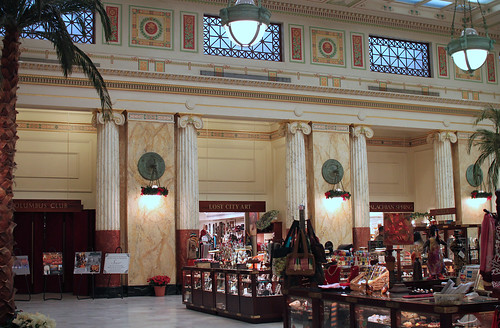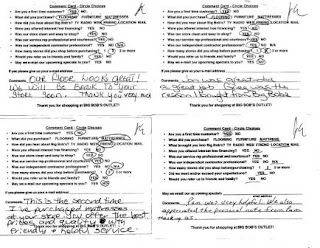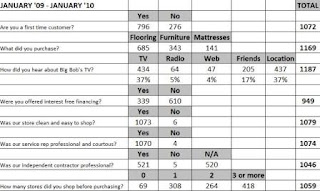
I'm fascinated with marketplace trends and how consumers react to social forces and economic conditions. After all, that's what affects the retail experience. As a result, I like to observe consumer behavior and identify patterns - by watching myself and those around me, listening to conversations and doing lots of research.
In the process of doing research, I've come across several resources about the consumer and the marketplace. I share them with you here. I'd love to hear your reactions and how you see some of these trends reflected in your market and retail environment.
2010 Consumer & Marketplace Trends, Insights and Predictions
JWT [once upon a time known as
J. Walter Thompson] offers a goldmine of resources worth investigating:
+
JWT Anxiety Index Blog and
Trends and Research+
JWTIntelligence.com Blog and
Trendletters, etc.Of particular interest is
Work In Progress: 10 Trends For 2010, a 32 page report available for purchase that I received a copy of. I consider this a longterm trend reference as it filled with thoughtful and relevant insights about consumers and the marketplace. Others must, too, as the 2009 report is also available for purchase. In its 5th year, the document is put together by
Ann Mack, JWT's director of trendspotting and reviews the year's trends while setting the stage for what's to come "
in the economy, the culture, the aging population, and the environment."
Macks's 10 trends that will drive consumers in 2010 include:
+ searching for stability
+ reading the fine print
+ maximum disclosure
+ the devil wears packaging
+ it's BIC and it's bigger than ever
+ trickle-up innovation
+ retooling for an aging world
+ life in real time
+ location-based everything
+ visual fluency
The Retail:Next Studies, Fad or Trend? Will recessionary shopping behavior continue from October, 2001 is a free download with registration to RetailWire. It addresses:
+ Longevity and Lasting Impact
+ Economic Values
+ Lifestyle changes
+ Shopping Patterns
+ Shopper Behavior
+ Store Experience vs. Value
SheSpeaks: Social media strong driver of purchase behavior among women refers to the
2nd Annual Social Media Study which details how women are participating in social media and how that participation affects their purchase behavior.
The 10 Customer Service Trends for 2010 by Barry Moltz details how important customer service is. It is "
the new marketing... It's time to offer outstanding customer service only because it makes economic sense for your small business. It is the only truly sustainable competitive advantage."
Barry's top trends include:
+ We try harder.
+ It's not your product.
+ It's all about you.
+ Tell the world.
+ The brands are listening.
+ Online service gets a face lift.
+ Insourcing is in.
+ That's tight.
+ Fire them.
+ Get small.
These next three articles appeared in May 2009:
Coping With Consumers' Newfound Frugality from AdAge, 5/21/09 by Avi Dan urges rethinking of assumptions around product, promotion, price as well as place.
The New Consumer Priority is Saving, Not Spending by
ReturnPath's Stephanie Miller includes fascinating stats about consumers. I love her closing statement "
Bottom line: consumers want interdependency, not independence of channels. Be sure to combine your search, bricks, website, email, social networks."
Study: The Three Stages Of Trading Down by Sarah Mahoney makes reference to quality and value, offering consumers information about their purchases and the continuing importance of sustainability and local sourcing. Yes, the article is about food shopping, but extrapolate from it for your product category.
These resources combined with many conversations and my observations led to my most recent Floor Covering Weekly article which appears in the Surfaces edition. It is titled "
Have you adapted your retail experience?" In it, I refer to 3 categories of consumer influence - the era of frugality, not trusting marketers, and a definition of value that includes wanting to improve the world - and 3 areas of opportunity for 2010 - make it simpler, don't lie to her or waste her time, and don't make her regret she bought from you.
Two new additions:
+ From
Mintel, a leading market research company, comes seven consumer behavior trends for 2010. More specifically, resilience, reviewing & re-evaluating, prove-it -- accountability, escapism, media evolution, ethical responsibility and stability.
Read the full document titled Mintel Predicts Global Consumer Trends.
I'll leave you with my friend David
Polinchock's Ponderings. David offers some of the most insightful retail and brand experience insights around and has just published
A Look Forward, Some Predictions from 2010 which refers to:
1. Authenticity continues to be critical
2. As social media grows, people will demand much more from brands
3. Brands must learn that they
start the conversation and that people
amplify it.
4. If you don't give me information, I'll go to someone who will.
5. We need to expand the Experience Continuum.
6. To expand the Experience Continuum, we need to start creating
Oneline experiences.
7. We'll start to understand the importance of Location Based Branding.
8. Augmented Reality and QR codes will become mainstream.
9. Physical retail needs to adapt or face the consequences.
Note: 'oneline' refers to how we live our lives increasingly moving between off and online and integrating the two.
Back to my original question, what are your reactions? How do you see some of these trends reflected in your market and retail environment? Are there any you've noticed that aren't included here?
 Save the date for the MarketingProfs B2B Forum 2010! It's happening in Boston from May 3rd through 5th, 2010.
Save the date for the MarketingProfs B2B Forum 2010! It's happening in Boston from May 3rd through 5th, 2010.







